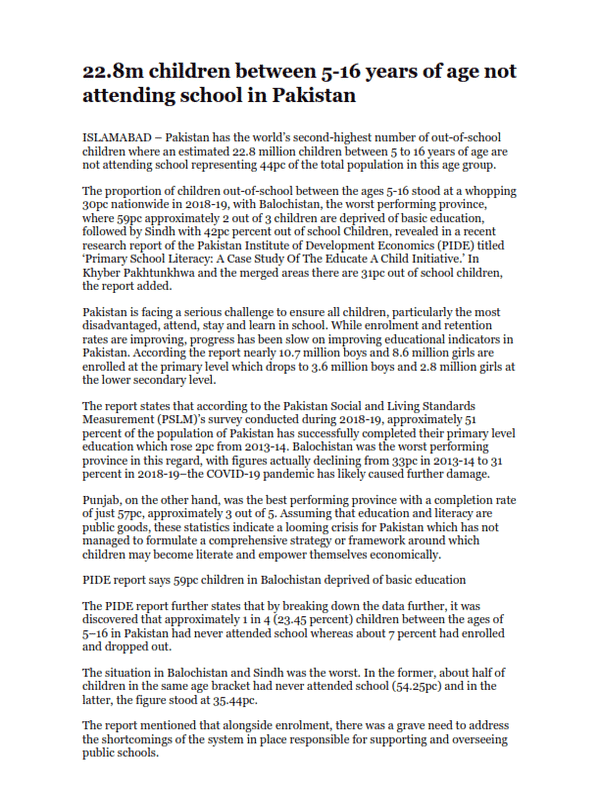22.8m children between 5-16 years of age not attending school in Pakistan
ISLAMABAD – Pakistan has the world’s second-highest number of out-of-school children where an estimated 22.8 million children between 5 to 16 years of age are not attending school representing 44pc of the total population in this age group.
The proportion of children out-of-school between the ages 5-16 stood at a whopping 30pc nationwide in 2018-19, with Balochistan, the worst performing province, where 59pc approximately 2 out of 3 children are deprived of basic education, followed by Sindh with 42pc percent out of school Children, revealed in a recent research report of the Pakistan Institute of Development Economics (PIDE) titled ‘Primary School Literacy: A Case Study Of The Educate A Child Initiative.’ In Khyber Pakhtunkhwa and the merged areas there are 31pc out of school children, the report added.
Pakistan is facing a serious challenge to ensure all children, particularly the most disadvantaged, attend, stay and learn in school. While enrolment and retention rates are improving, progress has been slow on improving educational indicators in Pakistan. According the report nearly 10.7 million boys and 8.6 million girls are enrolled at the primary level which drops to 3.6 million boys and 2.8 million girls at the lower secondary level.
The report states that according to the Pakistan Social and Living Standards Measurement (PSLM)’s survey conducted during 2018-19, approximately 51 percent of the population of Pakistan has successfully completed their primary level education which rose 2pc from 2013-14. Balochistan was the worst performing province in this regard, with figures actually declining from 33pc in 2013-14 to 31 percent in 2018-19–the COVID-19 pandemic has likely caused further damage.
Punjab, on the other hand, was the best performing province with a completion rate of just 57pc, approximately 3 out of 5. Assuming that education and literacy are public goods, these statistics indicate a looming crisis for Pakistan which has not managed to formulate a comprehensive strategy or framework around which children may become literate and empower themselves economically.
PIDE report says 59pc children in Balochistan deprived of basic education.
The PIDE report further states that by breaking down the data further, it was discovered that approximately 1 in 4 (23.45 percent) children between the ages of 5–16 in Pakistan had never attended school whereas about 7 percent had enrolled and dropped out.
The situation in Balochistan and Sindh was the worst. In the former, about half of children in the same age bracket had never attended school (54.25pc) and in the latter, the figure stood at 35.44pc.
The report mentioned that alongside enrolment, there was a grave need to address the shortcomings of the system in place responsible for supporting and overseeing public schools.
These institutions have historically struggled to address problems such as teacher absenteeism, low enrolment, high dropout, and poor physical conditions. The reason for this is a lack of resources and underdeveloped monitoring/governance mechanisms—along with the absence of any substantial coordination mechanisms.
According to the PIDE’s report there is a need for the establishment of local, grassroots level entities that could act as intermediaries between targeted populations and the governing agencies. The report emphasised that gaps in service provision at all education levels are a major constraint to education access. Socio-cultural demand-side barriers combined with economic factors and supply-related issues (such as availability of school facilities), together hamper access and retention of certain marginalized groups, in particular adolescent girls. Putting in place a credible data system and monitoring measures to track retention and prevent drop-outs of out-of-school children is still a challenge.
At the systems level, inadequate financing, limited enforcement of policy commitments, and challenges inequitable implementation impede reaching the most disadvantaged. An encouraging increase in education budgets has been observed at 2.8pc of the total GDP, it is still well short of the 4pc target, the report added.




